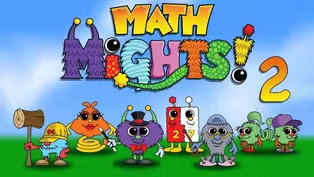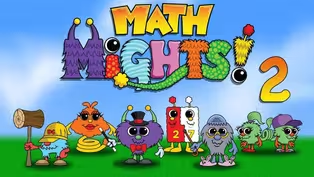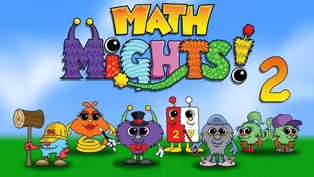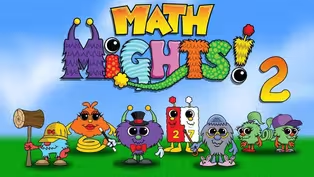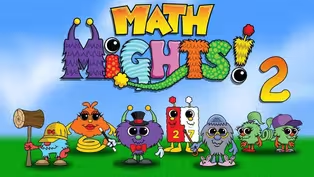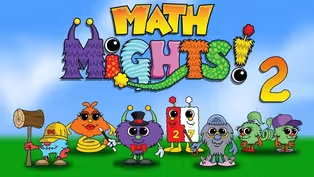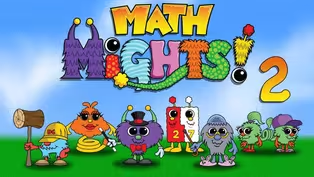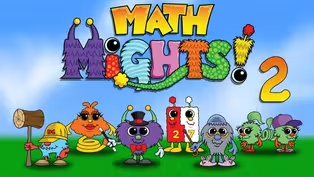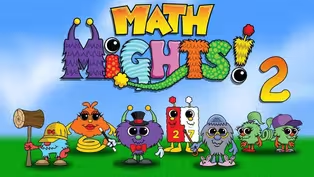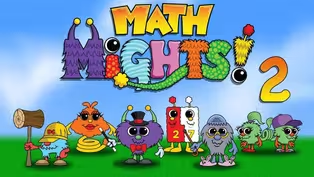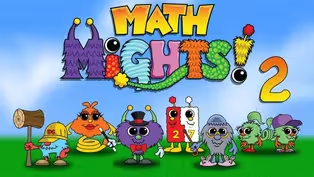Math Mights
Order 3-Digit Numbers
Season 3 Episode 306 | 15m 59sVideo has Closed Captions
Join Mrs. McCartney for a comparison word problem with her friend Professor Barble.
Join Mrs. McCartney for a comparison word problem with her friend Professor Barble. Next, get ready to order 3-digit numbers using place value understanding. Wewill be using number lines and Value Pak to help apply our thinking.
Problems playing video? | Closed Captioning Feedback
Problems playing video? | Closed Captioning Feedback
Math Mights is a local public television program presented by Detroit PBS
Math Mights
Order 3-Digit Numbers
Season 3 Episode 306 | 15m 59sVideo has Closed Captions
Join Mrs. McCartney for a comparison word problem with her friend Professor Barble. Next, get ready to order 3-digit numbers using place value understanding. Wewill be using number lines and Value Pak to help apply our thinking.
Problems playing video? | Closed Captioning Feedback
How to Watch Math Mights
Math Mights is available to stream on pbs.org and the free PBS App, available on iPhone, Apple TV, Android TV, Android smartphones, Amazon Fire TV, Amazon Fire Tablet, Roku, Samsung Smart TV, and Vizio.
Providing Support for PBS.org
Learn Moreabout PBS online sponsorshipMore from This Collection
"Math Mights" lessons for 2nd Grade students.
Video has Closed Captions
Join Mrs. McCartney for some fun with Professor Barble. (15m 59s)
Video has Closed Captions
Join Mrs. McCartney for some fun with Professor Barble. (15m 59s)
Video has Closed Captions
Join Mrs. McCartney for some fun with Professor Barble doing a tricky comparison. (15m 59s)
Video has Closed Captions
Join Mrs. McCartney for a word problem with Professor Barble that will make more sense. (15m 58s)
Compare 3-Digit Numbers Part 2
Video has Closed Captions
Join Mrs. McCartney to learn how to do a comparison word problem with Professor Barble! (15m 59s)
Comparing Numbers on a Number line
Video has Closed Captions
Join Mrs McCartney for a word problem with Professor Barble using Visula Models! (15m 59s)
Compare 3-Digit Numbers Part 1
Video has Closed Captions
Join Mrs. McCartney to see if we can figure out Professor Barble's comparison. (15m 59s)
Numbers represented in different ways
Video has Closed Captions
Representing numbers in different ways to show off your learning with place value. (15m 59s)
Video has Closed Captions
Put numbers together and taking them apart with expanded form. (15m 59s)
Video has Closed Captions
Join Mrs, McCartney for a Number Talk with her friend Springling! (15m 59s)
Video has Closed Captions
Join Mrs, McCartney for a Number Talk with her friend Springling! (16m)
Subtraction with 2-Digit Numbers Part 2
Video has Closed Captions
Join Mrs. McCartney for an addition number talk with D.C.! (16m)
Providing Support for PBS.org
Learn Moreabout PBS online sponsorship(upbeat music) - [Students] Math Mights.
- Welcome back, second grade Math Mights.
My name is Mrs. McCartney.
I'm so excited that you've joined us today to learn math together.
Today, we're gonna be doing a warmup with professor Barble doing a word problem, and then we're gonna be working on ordering numbers.
Well first, we're gonna start off with looking at professor Barble and seeing if he can help us warm up our math brain today by conquering word problems with visual models.
You might be wondering what a visual model is.
It has lots of different names.
Sometimes it's known as a model drawing, a unit bar, a tape diagram, or even a bar model.
It's a great reading comprehension strategy.
It also is a drawing that the visual model really will help you to create the strategy and understand the word problem better without guessing how to solve it.
Professor Barble is a character in Mathville that loves to solve word problems.
In fact, he has a thinking cap on his head that when he pushes on it, a starting line comes out to help him to start to think of where to start with the problem.
Let's read the word problem.
Diego read 15 more pages than Jada.
Jada read 38 pages.
How many pages did Diego read?
Amir thinks that, "Maybe we should add."
Tavon says, "Wait, or should we subtract?"
Oh, we're not gonna guess on if we should add or subtract.
Professor Barble wants to us to use the seven steps to help us get through our visual model.
Let's read and chunk the problem.
Diego read 15 more pages than Jada.
Repeat, Diego read 15 more pages than Jada.
Go ahead and say it, chunk.
Jada read 38 pages.
Repeat, Jada read 38 pages, chunk.
How many pages did Diego read?
Repeat, how many pages did Diego read?
Chunk.
We now have three chunks in our word problem to help us understand what we're looking at.
The next part is to create our sentence form.
The sentence form reads, Diego read (indistinct) pages.
(indistinct) means, I don't know the answer to that.
That's why we have to solve it.
It's important to use the sentence form so we know exactly what we're solving for.
It's now time to call on professor Barble to push on his thinking cap to help us get our starting line.
If you look here, I already have our starting line.
So when we start to look at step three, which is our who or what, are who is Diego and Jada and our what is the pages.
Step four is to put in the unit bars.
As you can see here, I've already put the unit bars in here.
They're both the same exact size, which really helps us in a problem like this to get started.
Step five is to go back into the chunks and check when the parts are added.
This is a really hard part for second graders.
So let's do it together.
The first chunk said that Diego read 15 more pages than Jada.
So here is Diego's.
This is their amount, there's Jada's amount.
So I know I wanna make Diego's bar larger.
And so I'm gonna put 15 in here.
Now that I have that information, I want to go back to my problem and check.
So we have that information added.
The next part says that Jada read 38 pages.
Going here, I can look at her bar and I can go ahead and add that information that she has 38 pages read.
Going back to the word problem, we can put that check-in.
Next is the part where we put in the question mark.
This is where we want to see where we need to solve the problem.
I can see it says, how many pages did Diego read?
So I'm gonna put the question mark here.
So I know that's where we need to solve.
Now, we're gonna go back to the problem and put the check-in.
Step six is to correctly compute and solve the problem.
Amir said that slowing down really helped, thanks professor Barble.
And Tavon said, "Oh wow, I didn't understand "the problem at first."
That's the best part about visual models is that now you can look at our visual model and I know exactly what I'm solving for.
You don't have to guess if you have to add or subtract, let's take a look.
It says, the question mark is at the end, these unit bars are equal.
So I know they originally had the same amount of books read and Diego read 15 more.
So I need to put these two parts together.
38 plus 15.
I'm gonna go ahead and solve this with DC.
And I'm gonna make this a friendly decade number by decomposing 15 into two.
So I can give it to the 38, leaving over here 13.
When I put my 38 and two together, I know that I have 40.
And when I add 13, it will tell me how many books Diego read, which is 53.
Step seven is to write the answer in the sentence form that we created.
So Diego read 53 pages.
Awesome job, boys and girls using professor Barble's seven steps to do a word problem.
You can try and use those steps on any word problem that you encounter.
Let's check out our, I can statement for today.
Our I cam statement says, we can order three-digit numbers using place value understanding.
Let's look to see who is out of order.
Kiran and Andre put a list of numbers in order from least to greatest.
Take a look at those.
Who do you agree with?
Do you agree with the way Kiran did it, or do you agree with the way Andre ordered it?
I asked our friend Amir and he said, "I disagree with Kiran because 269 comes before 272 "on the number line."
Let's take a look.
I have Kiran's numbers listed here the way that he wrote them.
He said, 207, 217, 272 and 269.
Our friend Amir is talking about these two numbers as he's looking at it on the number line.
He's saying here, when he's plotting the number that he is going to see 269 first, and then they're gonna see 272.
So he's thinking that we need to switch the order of these two numbers.
Do you agree with what Amir said?
Did you catch that same thing that Kiran did?
Is this the only way that we can compare the numbers?
Let's take a look to see what our friend Tavon thought.
Tavon said, I also disagree with Kiran, but he has a different reason.
He said 269, I know that there's six tens and in 272 there's seven tens.
So, 269 would come first.
Let's take a look to see what Tavon was thinking.
He said he disagreed because he saw the six tens and the seven tens.
This is also a really great strategy cause when you're counting, you would hit the 60's before you would hit the 70's.
So he is also correct that the numbers are out of order the way that Kiran did it.
Great job boys picking the number line as an option to look at, and then to actually look at the value of the numbers with Value Pak as a way to order numbers.
Let's see if we can order these numbers from least to greatest.
I have a number line there that can help you to be able to order the numbers.
Let's take a look here.
We have the number 839, 765, 788, 815 and 719.
What would be your first thing as a second grader if you were gonna start to order these numbers that you want choose to do first.
We've talked about lots of different strategies that we could have.
You can use the number line to help you.
We can look at the hundreds, the tens or the ones.
So let's take a look.
If I was going across my number line, I might wanna see which number am I gonna come to first.
Eliminating the numbers that are in the 800's will help me find the lowest cause we're looking at something in the 700's.
If I started counting first, am I gonna hit 760's, 780's or 710.
We would know as we're counting, we would probably get to the tens, which would equal 719.
So we're gonna order that number first.
Let's look at our next numbers that we're coming to.
We're going to continue in the 700's.
So we probably could leave those 800's flipped over.
Let's look now between 765 and 788.
On the number line, I can see that I'm gonna hit 760's before I'm gonna hit the 780.
So what does that tell us about which number should be next?
I hope you said 765.
We're gonna go ahead and order that next, which makes this number easy.
Why do I know that both of these numbers are not gonna go in the order next, because they're in the 800's.
So we're gonna order it here by putting 788 here.
Next as we start to move into the 800's, I can see that both of these values are 800.
Now that I go into the tens, am I gonna come to 810 first or 830 first.
As we look on our number line, we obviously see that 810 would come before 830, this 815 falls right in the middle.
So we're gonna put that next and then last but not least our 839.
As we can see all of these are in order from least to greatest.
You did a great job ordering those numbers from least to greatest.
Now we're gonna switch it up to see with these numbers, if you can order them from greatest to least.
Let's take a look here.
I have 199, 245, 173, 218, 137.
I'm gonna start by plotting the numbers on the number line this time.
I'm gonna start off with the number 199.
And I'm gonna kinda say that that goes right around here.
My next one is 173.
So I'm gonna go ahead and put a mark here and mark there as 173.
My next number is 218.
I'm gonna go ahead and plot that on the number line here, 218.
Now I'm gonna do 245, which is going to be located over here.
And last, I'm gonna go ahead and do 137.
Now that I have the numbers plotted on the number line, how was that going to help me with ordering the numbers?
Last time we were looking really closely at each of the values of the numbers and were kind of looking at them each individually on the number line, and then we were ordering them.
I did a little bit differently here.
So if we look down at our number line, I now have them already in order from least to greatest, but in this problem, they want us to put it in from greatest to least.
We know when we look at the number line, the greatest number, the larger number is off to the right.
On the left side we know we have the lower number.
So I'm gonna start to order mine by putting 245, then 218, then I'm going to do 199, 173, and then last but not least, 137.
I now have my numbers ordered from greatest to least.
We ordered those sets of numbers two different ways.
Let's take a look at this question.
Was it more helpful for you to put the numbers in order first or put them in the number line first?
Can you explain.
Our friend Amir says, "I think when you locate "the numbers on the number line first, it's easier "because they are already in order."
Did you notice that when we plotted these numbers that you see here on our number line, they were already in order for us.
So Amir thinks it's easier just to take the numbers and go ahead and plot them on the number line.
And then they're in order whether you're doing them from least to greatest or greatest to least.
Great thinking Amir.
Number lines in second grade are really helpful for us to be able to order numbers.
Look at these numbers on the number line, which number is the least, and which is the greatest.
Explain how you know?
Let's see what our friend Tavon says.
He says, "It is easy to see 415 is the least "because it's all the way to the left on the number line.
"545 is all the way to the right, so it is greater."
If we look here at the number line that does help us see when we see the number 415 all the way here on the left, and then we see 545 all the way over here on the right.
It lets you know that the numbers, when you're counting them on the number line, the least or the lower number is going to come first and the higher number is going to come last.
Great thinking Tavon as we use the number line to help us to figure out the least and the greatest number.
It's a really great tool for us to have as second graders.
We've done a lot with ordering numbers.
Which tool would you choose to order numbers?
Would you use the number line like Amir likes, or would you choose to use the digits with Value Pak, or would you go back to using the base 10 blocks.
Our friend Tavon says that using the base 10 blocks might take too long to order the numbers.
He likes to use Value Pak cause it helps them to see the value.
The nice part about this is you can use whatever tool helps you to be able to order numbers the easiest.
Guess what?
It's your turn now to help the Value Pak get in order, they are completely out of order and they need your help.
I hope that you have fun playing this game.
Thanks so much boys and girls for joining me on the second grade Math Mights.
I hope to see you in an episode soon.
(upbeat music) - [Announcer 1] sis4teachers.org.
Changing the way you think about math.
- [Announcer 2] This program is made possible with funding from the Michigan Department of Education.
Governor's Education Emergency Funds, the State of Michigan, and by viewers like you.


- Home and How To

Hit the road in a classic car for a tour through Great Britain with two antiques experts.












Support for PBS provided by:
Math Mights is a local public television program presented by Detroit PBS
